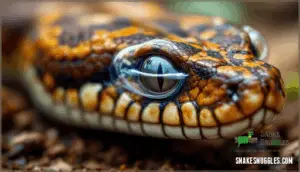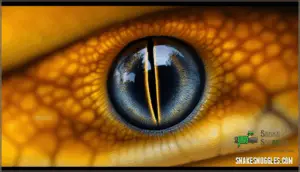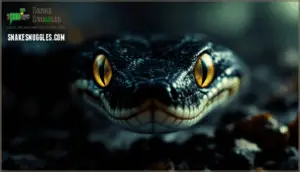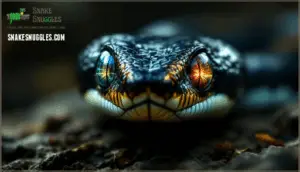This site is supported by our readers. We may earn a commission, at no cost to you, if you purchase through links.

This fixed shield maintains hydration, blocks debris, and grants continuous environmental monitoring without the interruption of periodic closure. The adaptation proves invaluable for burrowing species pushing through soil and arboreal hunters moving through dense vegetation, where momentary blindness could mean missed prey or collision.
What snakes sacrifice in the comfort of blinking, they gain in relentless vigilance—a trade-off refined across millions of years.
Table Of Contents
- Key Takeaways
- Can Snakes Blink?
- Snake Eye Structure
- Brille: The Snake’s Transparent Eyelid
- Pupil Constriction
- Snake Vision
- Snake Sleep
- Research on Snake Eyes
- Importance of Snake Eyes
- Frequently Asked Questions (FAQs)
- Why snakes don’t blink?
- Do snakes blink their eyes?
- Do snakes have eyelids?
- Can snakes move their eyes?
- How do snakes detect their prey?
- What is the role of a snakes Jacobsons organ?
- Can snakes hear sounds in their environment?
- How do snakes use their tongue for olfaction?
- What types of locomotion do snakes use?
- Do snakes have eyelids at all?
- Conclusion
Key Takeaways
- Snakes can’t blink because they lack eyelids entirely—instead, a transparent scale called a spectacle (or brille) permanently covers each eye, providing continuous protection while allowing uninterrupted vision for hunting and navigation.
- The spectacle sheds with the rest of the snake’s skin during molting, and proper humidity is critical for clean separation to prevent retained spectacles that can compromise eye health and vision.
- Snake pupils actively constrict and dilate to adapt to changing light conditions, with nocturnal species permitting UV light passage for enhanced low-light detection while diurnal species block UV to protect retinal tissue.
- Most snakes have dichromatic vision (perceiving only two primary colors) rather than the three-color vision humans possess, yet this specialized visual system—combined with heat detection and chemical sensing—proves highly effective for survival across diverse habitats.
Can Snakes Blink?
Have you ever locked eyes with a snake and wondered if it might blink first—only to realize, with growing unease, that its gaze never wavers? That’s because snakes can’t blink. They lack eyelids entirely.
Instead, a transparent scale called a spectacle—or brille—covers and protects their eyes permanently. This built-in shield dispels the blink myth: snakes don’t close their eyes, limiting vision interruption but requiring spectacle care during shedding to maintain proper snake perception and eye movement.
Snake Eye Structure
Understanding how snakes see starts with recognizing that their eye anatomy diverges sharply from the mammalian blueprint you’re familiar with—no movable eyelids, no blinking reflex, just a fixed transparent scale doing all the protective work. Beneath this spectacle lies a recognizable reptilian vision system: a cornea, lens, and retina structure adapted for detecting motion and contrast.
The spectacle function extends beyond corneal protection—it maintains moisture and shields against debris, critical for species that burrow or hunt in dense vegetation. Eye scales vary in thickness depending on habitat; fossorial snakes possess thicker brilles than arboreal hunters.
Your snake’s visual acuity depends on this layered arrangement working seamlessly. The absence of eyelids eliminates blinking interruptions, granting continuous environmental monitoring. This snake eye structure reflects millions of years of refinement, prioritizing survival over the luxury of periodic eye closure.
Brille: The Snake’s Transparent Eyelid
The spectacle—or brille—is that transparent shield you’ve been reading about, a modified scale fused permanently over the cornea that replaces traditional eyelids entirely. This transparent layer forms during embryonic development, creating built-in eye protection that never opens or closes—no blinking, no lid movement, just constant coverage.
Think of brille formation as evolutionary ingenuity. Your snake’s ancestors traded movable eyelids for a fixed window that offers uninterrupted vision while keeping dust, moisture loss, and physical damage at bay. This eye adaptation proves especially valuable for fossorial species moving through soil and debris.
Snakes traded movable eyelids for a fixed transparent window, an evolutionary adaptation that ensures uninterrupted vision while protecting against dust and debris
During spectacle shedding, the outer brille layer peels away with the rest of the skin, revealing a fresh protective surface underneath. You’ll notice cloudiness before a shed—that’s fluid building between old and new layers, temporarily affecting vision until the process completes. Proper humidity facilitates clean separation, preventing retained spectacles that compromise eye health.
Pupil Constriction
Beyond the fixed spectacle lies another layer of optical refinement—your snake’s pupils actively respond to changing light conditions, constricting to protect sensitive retinal tissue from UV damage while maximizing visibility in darkness. This pupil control mechanism works independently of the immobile brille, demonstrating refined light adaptation through precise iris movement.
Pupil constriction fulfills multiple functions in snake eye anatomy:
- Narrow vertical slits filter intense daylight, preventing retinal bleaching in diurnal species
- Wide dilation in low-light environments captures maximum available photons for nocturnal hunting
- Rapid adjustment between extremes facilitates crepuscular species to hunt during dawn and dusk transitions
- Continuous modulation maintains ideal retinal stimulation regardless of ambient conditions
This active eye protection improves overall snake vision, complementing the static spectacle with active vision enhancement that responds instantly to environmental changes.
Snake Vision
Your snake’s vision system represents a complex balance between spectacle function and specialized eye anatomy. Most snakes are dichromatic, expressing three visual opsin genes—rh1, sws1, and lws—that shape their color perception. Unlike the three-color vision you possess, snakes perceive only two primary colors in daylight, though this limitation doesn’t compromise their hunting success.
Light sensitivity varies dramatically between species. Diurnal snakes have lenses that block UV radiation, while nocturnal hunters permit UV light passage for enhanced low-light detection. This adaptation directly affects visual acuity and predatory efficiency. The study of snake visual evolution provides valuable insights into the development of these unique visual adaptations.
| Vision Feature | Adaptation Purpose |
|---|---|
| Dichromatic color perception | Optimized prey detection in specific wavelengths |
| UV-blocking lenses (diurnal) | Protects retinal tissue from solar damage |
| UV-permitting lenses (nocturnal) | Maximizes photon capture in darkness |
| Fixed spectacle coverage | Maintains continuous visual field without interruption |
Reptile vision in snakes lacks eye movement through traditional extraocular muscles—instead, the entire head repositions to track targets, compensating for immobile eyes beneath the protective brille.
Snake Sleep
When you watch your snake rest, that unblinking stare might seem unsettling, but it’s simply how these reptiles experience sleep—eyes locked open beneath their transparent brille while their retinal activity slows to a resting state. Unlike mammals, snakes don’t achieve eye closure during rest behavior, making it challenging to distinguish active observation from genuine sleep patterns.
Their circadian rhythms differ markedly from yours, with nocturnal habits dominating many species’ activity cycles. Research suggests snakes lack REM sleep entirely, instead entering lighter rest phases where environmental awareness persists.
Some species undergo brumation during winter—a torpor-like state where metabolic processes drastically reduce. This extraordinary adaptation allows survival through resource scarcity, demonstrating how snake eye anatomy and spectacles have evolved alongside unique sleep mechanisms that don’t require the protective blinking you depend on nightly.
Research on Snake Eyes
Scientific inquiry into snake eye anatomy has transformed how you understand reptilian vision and evolutionary adaptations. Researchers have documented that ancestral snakes likely possessed enhanced vision compared to modern burrowing species, with seven out of twelve genes linked to bright-light vision now absent in scolecophidian snakes.
Studies across 69 species reveal striking diversity in visual pigments, showing most snakes retain UV sensitivity despite habitat variations. Spectacle thickness correlates directly with environment—fossorial and aquatic species develop thicker brilles than arboreal counterparts.
Blood flow dynamics within the spectacle demonstrate precise regulation, with vessels constricting during visual threats to improve clarity. This research illuminates ocular disorders like subspectacular infections and pseudobuphthalmos, guiding veterinary treatment while deepening your appreciation for how snake eye anatomy reflects millions of years of adaptation to diverse ecological niches. Understanding the spectacle anatomy is essential for addressing these disorders effectively.
Importance of Snake Eyes
Your ability to understand how these exceptional organs function opens a window into one of evolution’s most elegant solutions to survival. Snake eye anatomy demonstrates intricate sensory integration, where the spectacle provides eye protection while maintaining visual sharpness across diverse habitats. Without eyelids, snakes developed environmental awareness through continuous vision, enabling refined hunting strategies that combine heat detection with precise movement tracking.
Consider how these adaptations transform survival:
- Nocturnal predators exploit pupil constriction to increase low-light sensitivity while filtering damaging UV rays
- Arboreal hunters maintain depth perception through specialized eye placement, vital for striking moving prey
- Burrowing species rely on thicker spectacles to shield against abrasive substrates during underground exploration
This eye adaptation showcases nature’s ingenuity—eliminating blinking created uninterrupted surveillance systems perfectly matched to ecological demands. Understanding snake eyes reveals why these reptiles thrive across ecosystems, from rainforests to deserts.
Frequently Asked Questions (FAQs)
Why snakes don’t blink?
Unlike creatures that blink reflexively, snakes evolved without eyelids—a fossorial adaptation from burrowing ancestors. Their brille, a transparent spectacle fused over snake eyes, provides continuous eye protection.
This evolutionary tradeoff sacrificed blinking for uninterrupted vision and nocturnal advantage, keeping the spectacle function constant through shedding cycles.
Do snakes blink their eyes?
Before the Victorian era of herpetology, naturalists believed snakes possessed hidden eyelids. Snakes don’t blink—their eyes lack movable eyelids entirely. Instead, the brille, a transparent spectacle fused to each eye, offers permanent protection.
This vision adaptation evolved through eye evolution, eliminating blinking and the blink myth while requiring specialized spectacle care during shedding.
Do snakes have eyelids?
Snakes lack eyelids entirely. Instead, a transparent scale called the spectacle—or brille—covers and protects each eye. This fixed structure shields against debris while allowing light through.
During shedding, the spectacle peels away with the old skin, renewing eye protection naturally.
Can snakes move their eyes?
Though you might think their fixed gaze limits movement, snakes possess extraocular muscles enabling subtle eye rotation and gaze control. This focal length adjustment helps track prey despite their transparent spectacle and absence of eyelids, expanding their vision range without blinking.
How do snakes detect their prey?
You rely on multiple sensory systems to track prey effectively. Your tongue collects chemical cues from the air, delivering them to the Jacobson’s organ for analysis—a form of taste-smell detection.
Heat pits located between your eyes and nostrils detect infrared radiation from warm-blooded prey.
What is the role of a snakes Jacobsons organ?
When you watch a snake’s tongue dart in and out, you’re witnessing chemical detection in action. The Jacobson’s organ processes tongue-delivered molecules, enabling snakes to track prey, identify mates, and navigate terrain through complex smell processing and sensory perception beyond ordinary olfaction.
Can snakes hear sounds in their environment?
You can detect sounds through vibration sensing, though snakes lack external ears. Their auditory system relies on skull bones and jawbones pressed against the ground, picking up environmental cues through vibration detection between 50–1,000 Hertz—critical for locating prey and avoiding predators.
How do snakes use their tongue for olfaction?
Like a compass needle seeking north, your snake’s forked tongue flicks through the air, capturing chemical signals that drift on invisible currents. When the tongue withdraws, it delivers these airborne molecules to the Jacobson’s organ—a specialized olfactory system in the roof of the mouth that decodes environmental information, transforming chemical traces into a sensory map.
What types of locomotion do snakes use?
You’ll find snakes using lateral undulation, sidewinding motion, concertina, and rectilinear locomotion techniques. These diverse movement strategies enable reptiles to thrive across varied terrains—from terrestrial slithering through grasslands to arboreal climbing in canopies, aquatic swimming in wetlands, and burrowing movement underground.
Do snakes have eyelids at all?
No, snakes don’t have eyelids—they lost this feature through evolution. Instead, their eyes are shielded by a transparent spectacle, or brille, which provides permanent eye protection.
This lidless vision system keeps the eye anatomy covered while allowing light to reach the snake iris, eliminating the need for blinking entirely.
Conclusion
What you see is what you get—and with snakes, that crystalline stare is more than meets the eye. Their inability to blink reflects a calculated evolutionary trade: constant visual input for vulnerability reduction.
The spectacle shields, moisturizes, and permits unbroken surveillance, proving that adaptation doesn’t require conventional solutions. When you wonder can snakes blink, remember their motionless gaze isn’t defiance—it’s optimization.
Every fixed lens tells a story of survival through structural innovation, where nature chose permanence over periodic closure.
- https://cordis.europa.eu/article/id/436488-why-can-t-snakes-blink
- https://animal-club.co.uk/do-snakes-blink/
- https://www.reddit.com/r/biology/comments/1l5fyke/snakes_dont_blink_but_how_do_they_keep_their_eyes/
- https://pmc.ncbi.nlm.nih.gov/articles/PMC5562989/
- https://academic.oup.com/mbe/article/33/10/2483/2925599












